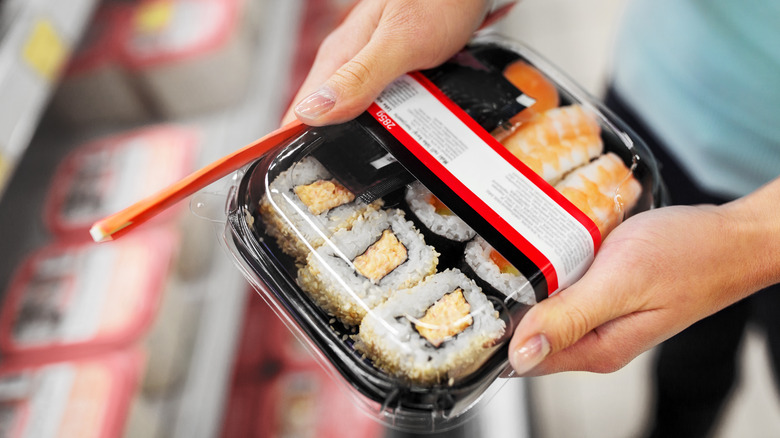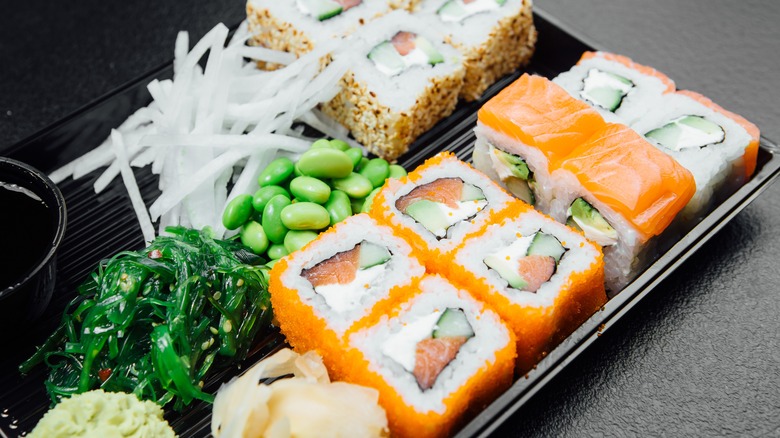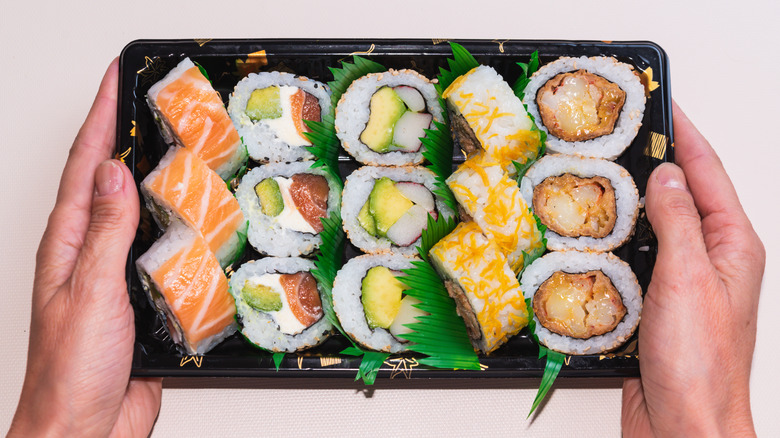The Red Flag To Watch Out For When Buying Grocery Store Sushi
We've all heard plenty about the dangers of consuming gas station sushi, but the same warning signs can apply to countless other sushi-selling locations. For instance, there are a number of risky sushi specials to avoid ordering at restaurants, lest you come down with a case of foodborne illness. But what about grocery store sushi? How can you differentiate the good stuff from the bad?
Before you even look at the sushi itself, a good rule of thumb is to take a look at the big picture for any obvious red flags. Piles of packaged sushi could suggest that not many people are buying the product –- and likely for a good reason. As such, the sushi might not be rotated out as frequently as it should be, leaving you with a selection of less fresh fish.
Conversely, if a grocery store has a designated sushi area and always seems to be sold out or on the brink of selling out, the product is probably good. What's more, this can force a store to restock more often, in turn increasing your odds of scoring a fresh meal.
Always check the date on grocery store sushi
Regardless of how often you see a grocery store restock its sushi, another red flag to look out for is the sushi's sell-by date. If the date is fast approaching, you should probably skip buying it. If the date is the current day, you can buy it but make plans to eat it as soon as possible. Be sure to check all the available packages and choose one from the back or bottom, where the shelves are cooler.
Even when refrigerated, sushi containing raw seafood must be consumed within one to two days of being made, so ideally you should eat it the same day. Speaking of, another red flag to look for is that the sushi is properly refrigerated. On a particularly hot day, the open-air refrigerators at the grocery store may not be able to keep up. It's critical that seafood is stored at temperatures of under 40 degrees Fahrenheit to prevent food-borne illness. Temperatures between 40 and 140 degrees Fahrenheit are known as the "Danger Zone" because they are ideal for bacterial growth.
Use all of your senses when buying grocery store sushi
Just as you should when buying any other kind of raw meat, you should always use your senses when shopping for sushi. Firstly, check the appearance of each component. The fish, rice, and any veggies should look fresh and moist. If any ingredient looks dried out, the sushi probably isn't very fresh. You should also examine the color of any seafood included — though the exact colors will depend on the type of seafood. In general, however, you don't want to see any obvious discoloration. Make sure the fish itself looks bright — not cloudy or opaque — as this means it isn't fresh and is therefore risky. Does the nori look wet, or is it starting to disintegrate? That sushi isn't fresh.
You should also perform a sniff test. Sushi should smell fresh, so a fishy odor can indicate that it has started to go bad. Although you might not be able to physically feel the sushi's texture, you should be able to see whether or not it's holding its shape or developing slime -– both of these textural changes are red flags for spoiled sushi. In the simplest of terms, if the sushi doesn't look quite right, or you have even the slightest of doubts about its quality, keep on walking to the nearest sushi bar for the freshest meal.



